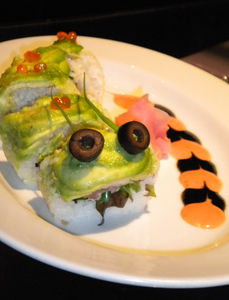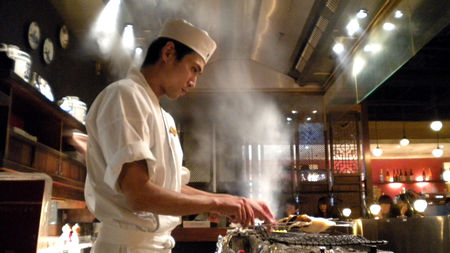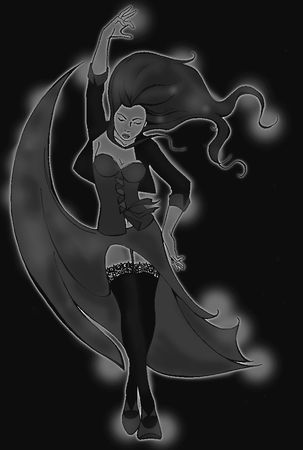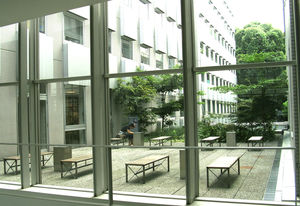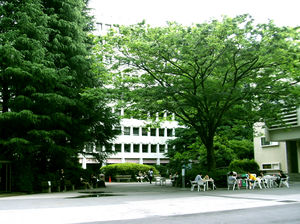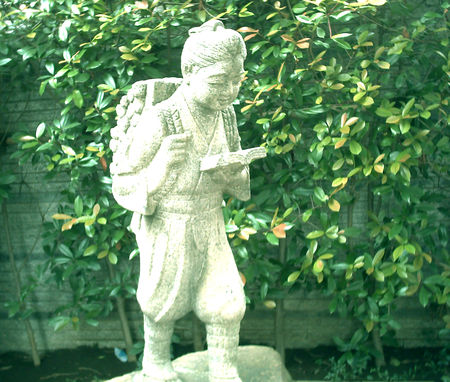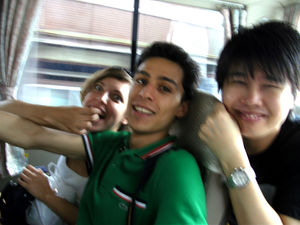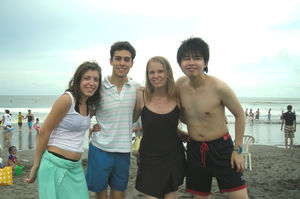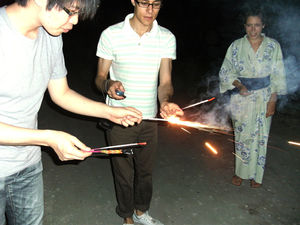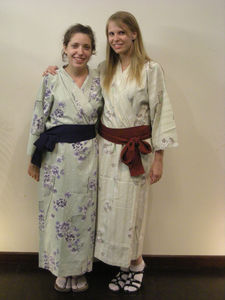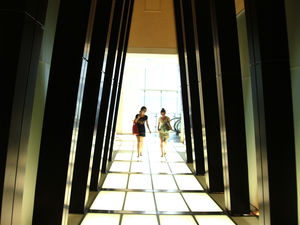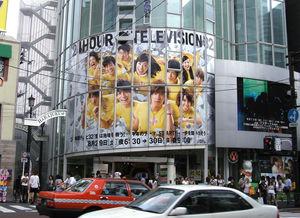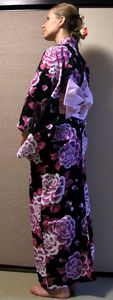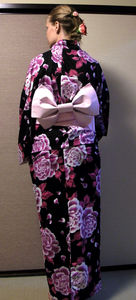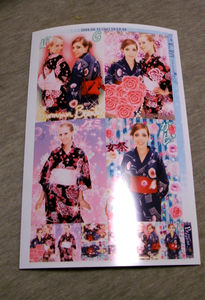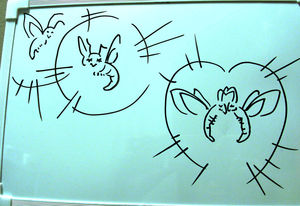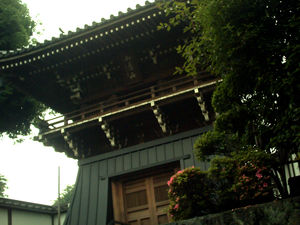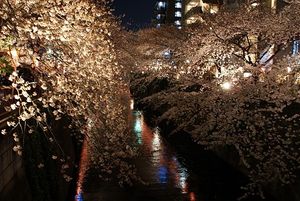World Twister Game
Can I leave in the faculty, please ?
Waseda University Campus Tour !
ETP JAPAN, 27th cycle : go, go, go !
Back to school...
sales, girls
Holidays : hello to the Pacific
Snow White Soon...
A+ is good for the ego
If the reader have any interest in the (long) essay I wrote about the Japanese TV drama for the validation of Paris' module, here it is !
A reflection of the Japanese society
through the
Japanese TV dramas
INTRODUCTION TO THE JAPANESE TV DRAMA
It is my purpose in this essay to
illustrate the various aspects of Japanese TV drama, and to address the issue
of auto-representation of the Japanese society through this unique mass media entertainment
production. The main focus of my expose will attempt to summarize how the
so-called “J-drama” reflect some of the main contemporary Japanese social
issues, and what image of the Japanese society they propose themselves to
convey.
Anyone who has got an experience of
living in Japan knows the importance of the “yearly inventory” of resources for
the  Japanese. In a certain extend, we can consider the whole production of
J-drama as a recurrent inventory of the
Japanese social resources. Beyond entertainment, the reflexive dimension of
J-drama refers to the mixed heritage of Confucianism and Buddhism in Japan,
which emphasizes the ability to make the
best possible use of every moment of enjoyment. If we can not forget the
commercial device behind the Japanese drama, nor their inequalities in terms of
relevance and quality, nor the “star-system” they depend on, let us look at the
social purpose which define most of them. Let us look at J-drama as a
continuation of Edo period’s ukiyo
(floating world), when popular entertainment also consisted in an analytic representation of emotions,
passions and human relations in general.
Japanese. In a certain extend, we can consider the whole production of
J-drama as a recurrent inventory of the
Japanese social resources. Beyond entertainment, the reflexive dimension of
J-drama refers to the mixed heritage of Confucianism and Buddhism in Japan,
which emphasizes the ability to make the
best possible use of every moment of enjoyment. If we can not forget the
commercial device behind the Japanese drama, nor their inequalities in terms of
relevance and quality, nor the “star-system” they depend on, let us look at the
social purpose which define most of them. Let us look at J-drama as a
continuation of Edo period’s ukiyo
(floating world), when popular entertainment also consisted in an analytic representation of emotions,
passions and human relations in general.
Let us also remember that in the
Japanese mindset, the eye of the others define what is proper (heritage of Confucianism).
In this way, the drama can be considered as modern social theatres, whose protagonists
and situations are shown to the public in order to acquire the general agreement which remains the main principle
of legitimacy in the Japanese society.
DESCRIPTION AND SPECIFICITY OF J-DRAMA
![]()
![]()
To get a
better understanding of the specificity of J-drama, we need to briefly explain
the particularity of their format, and their differences with the TV
productions which are familiar to the Westerners.
In opposite with our own TV-series
which are used to go on until the TV share audience decreases and provokes the
outcome of the scenario frame, Japanese drama are not made of successive “seasons”,
but are characterized by a pre-determined format, called renzoku. In other words, the
timing of J-drama is fixed by advance, and does not obey to the pressure of audience
- even if as for the American series, the narrative frame can be biased along
the way according to the objective of fostering the public’s loyalty.
Most of drama is made of ten or
twelve 45-minutes episodes[1], with
sometimes an opening or ending “special” one-hour movie (for instance, the “special”
episodes of Nodame Cantabile in Europa could
reach two full hours each). With one episode broadcasted every week[2], the
full unfolding of the story usually lasts more or less three months. Furthermore,
J-drama are usually not broadcasted twice on TV: only extremely popular drama,
as Hana yori dango, can be considered
for a second season (HanaDan 2) or, even
more rarely, for a theatre movie.
Regarding to their impact, J-drama’s popularity is obvious: the
normal audience for a drama is situated between 8 and 13%  of TV viewers and the
most successful of them can gather until 20 or even 30% of the public for the
first or the last episode (the equivalent of the American TV serie Lost, for instance, only reached 10% in
France). We should add that drama’s marketing packaging widely participates to
their success among the Japanese public. In addition, making-off takes place
only a few weeks before drama are broadcasted on TV, so the fan can enjoy
promotion events as well as for any cinematographic product. The launch of
famous manga adaptations into drama as GTO
or Ring, for instance, was similar to
highly expected movies’ releases.
of TV viewers and the
most successful of them can gather until 20 or even 30% of the public for the
first or the last episode (the equivalent of the American TV serie Lost, for instance, only reached 10% in
France). We should add that drama’s marketing packaging widely participates to
their success among the Japanese public. In addition, making-off takes place
only a few weeks before drama are broadcasted on TV, so the fan can enjoy
promotion events as well as for any cinematographic product. The launch of
famous manga adaptations into drama as GTO
or Ring, for instance, was similar to
highly expected movies’ releases.
Many drama’s scenarios are extracted
from original popular manga, but some of them were created especially for TV
use only. Drama can deal with any kind of subject : love stories (ren ai drama, like First Kiss for example), but also police investigations (Liar Game), so-called science-fiction (Sailor Moon Live Action), dramatic comedies
(Nodame Cantabile), horror, and so on.
However, the most appreciated category
is definitively « trendy drama », which focus on daily life issues and
relations, and where the protagonists are made to look credible according to
the Japanese social reality. In this way, it is very easy for the Japanese
public to identify to these types of “non-heroes”. For this reason, many
drama’s actions take place in familiar contexts such as high school (My boss my hero), offices (Anego)… Here is the first clue of the J-drama’s aptitude to question and to
represent the Japanese social issues.
[1] Except for the specific « tanpatsu drama », what is
more alike to our TV movie (two hours “closed-end” story).
[2] Almost all the Japanese TV channels are used to
propose various drama, but the most famous are Fuji TV, TBS, Wowow, TV Asahi, NTV and NHK (which morning drama is made
of 15-minutes episodes broadcasted all year long).
FOCUS ON TRENDY DRAMA
![]()
1. less program episodes and quick
rhythm;
2. appropriate roles and clear
background;
3. no restrictions for playwright;
4. great promotion and causing
leading fashion;
5. wide range of subjects and
catching the social pulse;
6. fine production and realistic
scene.
Furthermore, the author concludes
that trendy drama are characterized by:
1. cultural proximity
2. cultivation theory
3. social learning theory
4. use and gratification theory
5. empathy
6. realism & representation of social mainstream value.
In a certain extend, trendy drama
are the modern expression of the chônin
dô, the “way of common people”, which is the one of the majority of the
contemporary Japanese. In this way, we can say that they belong to the field of
Nihonjinron, which emphasize the myth
of the Japanese society as a people of “peasants”, an industrious economy where
it is difficult to emerge as an individual, and where the virtues of diligence,
honesty, quality of workmanship, gaman
(be enduring, patient, submissive) are encouraged.
But the “normal people”, who do not
follow any exceptional path, still follow a precise path. If they all walk in
the same direction, they still have to make their individual way. Drama have
the ability to represent this individual quest of the “normality”, of the right
balance between life standards and individual integrity. It clearly refers to
the concept of soul-searching (jibun-sagashi)
which historically defines Japan and the Japanese spirit.
In this context of uncertainty,
“Japanese must find new shields in individual resources and entourage”[2].
Focusing on normal people‘s daily questioning and search for their place in the
society, J-drama seem to open a window on the general issue of how to reinvent
a national identity.
Finally, our last entry for
interpretation would refer to the difficult conception of wabi-sabi aesthetic. Wabi-sabi
teaches to the Japanese to find a certain beauty in imperfection, to accept the
natural cycle of growth, decay and death. Trendy drama’s unfolding represents a
three-month season which rhythms the life of the Japanese, refusing to deliver
a closed message, which protagonists appear and disappear, carrying their
burden with grace, accepting the march of time, not really triumphing, but
surviving after all, going on doing their best (gambaru).
Leading on from these assumptions, we would like to present a few examples of chônin-dô issues represented by the Japanese trendy drama, through a non-exhaustive selection of j-drama which appeared particularly relevant to us.
[1] Lu-ping Kuo, An Analysis of Genre of Japanese TV Trendy Dramas in Taiwan and
Interpretation by Taiwan Audience
[2] Anne-Marie Guarrigue and Sylvie Chevallier, le Japon Contemporain, Ed Fayard 2007
Ie and mura
through trendy drama
![]() One of the main features on the trendy j-drama is to demonstrate that
the Japanese are definitely “contextual individuals”. Their personality does
not count for itself, but for a unique convergence of traits determined by
their surrounding – familial or social.
One of the main features on the trendy j-drama is to demonstrate that
the Japanese are definitely “contextual individuals”. Their personality does
not count for itself, but for a unique convergence of traits determined by
their surrounding – familial or social.
Here we find the concepts of ie (the house, the “inside” world) and mura (the close environment providing social marks) typical of the
Japanese society. J-drama deals with the crisis, but also with the continuation
of the ie-mura conception of the
world.
The story of Brother Beat is representative of this issue. Mura’s crisis is symbolized by the three different destinies uphold
by  the brothers of the same family. The elder son, an obedient salary-man
dedicated to his company, follows the prevalent way for Japanese men. His
well-organized life contrasts with the one of the second son, the stereotype of
the “freeter”, whose refusal to enter the system is a mix of rebellion and lack
of confidence toward the future offered by the imperfect mura. Half part-timer, half host,
he can’t prevent himself to recall the failures of the social system to his
more responsible brother. Finally, the last son is totally out of the “male”
path: nicer and sweeter than his brothers, his character looks like the missing
daughter’s role. Because one on his classmates becomes pregnant, he decides to
help her to raise the child, even if he is not the father. This unusual
behavior emphasizes the appeal of ie,
of the family links which resist to the crisis of mura. Moreover, the three brothers are connected by the central
protagonist, the mother, whose rules predominate on everything inside the
walls.
the brothers of the same family. The elder son, an obedient salary-man
dedicated to his company, follows the prevalent way for Japanese men. His
well-organized life contrasts with the one of the second son, the stereotype of
the “freeter”, whose refusal to enter the system is a mix of rebellion and lack
of confidence toward the future offered by the imperfect mura. Half part-timer, half host,
he can’t prevent himself to recall the failures of the social system to his
more responsible brother. Finally, the last son is totally out of the “male”
path: nicer and sweeter than his brothers, his character looks like the missing
daughter’s role. Because one on his classmates becomes pregnant, he decides to
help her to raise the child, even if he is not the father. This unusual
behavior emphasizes the appeal of ie,
of the family links which resist to the crisis of mura. Moreover, the three brothers are connected by the central
protagonist, the mother, whose rules predominate on everything inside the
walls.
The reverse side of the Japanese way of
life portrayed by the drama Ikebukuro
West Gate Park let us discover an uncertain  and threatening mura. While he investigates in the
neighborhood to understand the circumstances of a friend’s death, a young man
becomes involved in the troubles of various protagonists who haunt the area of
Ikebukuro.
and threatening mura. While he investigates in the
neighborhood to understand the circumstances of a friend’s death, a young man
becomes involved in the troubles of various protagonists who haunt the area of
Ikebukuro.
Daily delinquency, general insecurity, children abuse, drug, war of
gangs, prostitution, yakuza: the familiar world is everything but safe. Based
on a novel and a manga adaptation, the scenario challenges the stereotype of a
safe and disciplined Japanese society, to propose the vision of the
contemporary mura’s crisis.
On the opposite, the story of Gokusen offers a certain confidence in
the resources of the society to find the right balance  between official and
underground powers, through the destiny of the heiress of a yakuza family, who
is also a teacher in a low-ranked school of boys. As she realizes that her
students, who are considered as delinquents, all have to manage with various
social and familial problems, she decides to do her best to re-establish the
harmony in the society… using also her yakusa-related personal influence.
between official and
underground powers, through the destiny of the heiress of a yakuza family, who
is also a teacher in a low-ranked school of boys. As she realizes that her
students, who are considered as delinquents, all have to manage with various
social and familial problems, she decides to do her best to re-establish the
harmony in the society… using also her yakusa-related personal influence.
This
time, the crisis is on the side of ie:
parents and families in general do not play their role anymore and trouble the
social order, while the gangs of proximity take in charge their educative and
corrective missions.
The focus on ie and mura as revelators of the evolution of the social schemes also emphasizes the research of the right place to be for the individuals, which depends of the space the society allows us to take.
To find the right place, to follow the appropriate way
![]() Another psychological trait of Japanese people
we can find in the j-drama is the necessity for everyone to keep oneself in the
limit of the proper place. This heritage of the Tokugawa political thinking and
of the principles of Confucianism can be observed in the trendy drama which
mostly focused on “categories” of people (part-timers, salary-men, housewives,
students…) but is also questioned and challenged through a certain number of
stories.
Another psychological trait of Japanese people
we can find in the j-drama is the necessity for everyone to keep oneself in the
limit of the proper place. This heritage of the Tokugawa political thinking and
of the principles of Confucianism can be observed in the trendy drama which
mostly focused on “categories” of people (part-timers, salary-men, housewives,
students…) but is also questioned and challenged through a certain number of
stories.
In DragonZakura, a lawyer reconverted into
a pedagogic consultant for a second-zone high-school tries to convince a group
of  students in difficulty that they can access to the prestigious University of
Tokyo. From his point of view, the school system offers to them a unique chance
to escape to a no-future destiny; in other words, the students should use the
system instead of keeping being the victims of it. In front of the difficulty,
the candidates for Todai have to wonder where they should be. Should they
accept their present situation and renounce to any chance of social ascension without
complaining? Should they do their best to climb the social gap and to justify
the school system’s opportunities? The drama challenges two contradictories
traits of the Japanese spirit: the emphasis on destiny’s acceptance, and the
one on giving the best of you on every doing (gaman against gambaru).
students in difficulty that they can access to the prestigious University of
Tokyo. From his point of view, the school system offers to them a unique chance
to escape to a no-future destiny; in other words, the students should use the
system instead of keeping being the victims of it. In front of the difficulty,
the candidates for Todai have to wonder where they should be. Should they
accept their present situation and renounce to any chance of social ascension without
complaining? Should they do their best to climb the social gap and to justify
the school system’s opportunities? The drama challenges two contradictories
traits of the Japanese spirit: the emphasis on destiny’s acceptance, and the
one on giving the best of you on every doing (gaman against gambaru).
The protagonists of Nobuta o Produce have to comply with
their intern conflicts between honne
and tatemae. The distortion  between their
true thinking and their social being is highlighted by the revelation of their
intern monologue and their fundamental indifference to the others that they
carefully hide under a friendly-character simulation. The leader of the class,
secretly anxious that anyone discovers his fake attitude towards his
classmates, tries to improve his self-control teaching the shy and rejected
new-comer Nobuko to act in a proper way to become popular.
between their
true thinking and their social being is highlighted by the revelation of their
intern monologue and their fundamental indifference to the others that they
carefully hide under a friendly-character simulation. The leader of the class,
secretly anxious that anyone discovers his fake attitude towards his
classmates, tries to improve his self-control teaching the shy and rejected
new-comer Nobuko to act in a proper way to become popular.
The fear to loose
his rank, his place in his little group slightly turns into a deeper fear, the fear
to never find a proper place in the society.
These two examples
highlight the issue of acceptance of the society and acceptance by the society.
We can refer to a drama which does not belong to the definition of “trendy
drama”, but which also focuses on realistic situations, and which aims to portray
the Japanese society: Kurosagi.
which does not belong to the definition of “trendy
drama”, but which also focuses on realistic situations, and which aims to portray
the Japanese society: Kurosagi.
After the quest of the
right place, this drama tends to illustrate the concept of “do”, the personal way anyone should
follow, according to his true self. Kurosagi’s
protagonist is a young man whose father committed suicide after loosing all his
money in a swindle. Despite of his young age, he decides to fight against every
swindler who dares to trouble the social harmony. Becoming a swindler himself,
he dedicates his life to this quest, rejecting any relation, any situation that
could distract him from his goal.
The pressure on individuals to choose and follow a precise path also leads them to the confrontation and to a certain competition with each other. Let us now turn our attention on the way that trendy drama describe these intern conflicts, especially in the professional context.
Japan Co, the theatre of social conflicts
![]() To portray the “way of common people”, trendy
drama often take place in the frame of the corporate world. This is the place
where the Japanese people are supposed to find their place in the society, to
determine their true identity. But instead of showing the successes of the
Japanese corporate machinery, j-drama mostly focus on the creatures who remain
at the fringe of the group dynamic: office ladies more or less waiting for a
marriage to quit the system, part-timers considered as second-hand workers, young
workers who can not wait for their age to finally allow them a bit of
consideration, and already “too old” female workers fearing that the new
generation would outdate them too early… Between “regulars” and “non-regulars”,
tensions appear, and the protagonist must comply with the requirement of
homogeneity and their own survival. Far from showing an inner Japanese unity,
trendy drama demonstrate that “being Japanese” is a long negotiation between
individuality and group-spirit.
To portray the “way of common people”, trendy
drama often take place in the frame of the corporate world. This is the place
where the Japanese people are supposed to find their place in the society, to
determine their true identity. But instead of showing the successes of the
Japanese corporate machinery, j-drama mostly focus on the creatures who remain
at the fringe of the group dynamic: office ladies more or less waiting for a
marriage to quit the system, part-timers considered as second-hand workers, young
workers who can not wait for their age to finally allow them a bit of
consideration, and already “too old” female workers fearing that the new
generation would outdate them too early… Between “regulars” and “non-regulars”,
tensions appear, and the protagonist must comply with the requirement of
homogeneity and their own survival. Far from showing an inner Japanese unity,
trendy drama demonstrate that “being Japanese” is a long negotiation between
individuality and group-spirit.
The so-called Anego (elder sister) is the most
competent worker of her team. Although anyone expects her to climb the  hierarchy because she was just hired to be and stay an OL (office lady), her
department could not work without her to overview and control the general
activity of the group. But even if every man of the team is thankful to her to
take care of everything, she is also despised as a woman to be 35 years old and
not married yet. Her colleagues explain her professional devotion referring to
the fact that she has no one else to care about in her life. Whereas she
wonders if her life will remains as empty as it is now (no sake in the company,
no sake outside), she observes how easily the young new-comer integrates
naturally to the clan of salary-men, because he is a man, and because he was
hired to have a career. While the kid becomes fascinated by this woman who
concretely runs the whole department, she can not prevent herself to see him as
the symbol of the inequality of their destinies.
hierarchy because she was just hired to be and stay an OL (office lady), her
department could not work without her to overview and control the general
activity of the group. But even if every man of the team is thankful to her to
take care of everything, she is also despised as a woman to be 35 years old and
not married yet. Her colleagues explain her professional devotion referring to
the fact that she has no one else to care about in her life. Whereas she
wonders if her life will remains as empty as it is now (no sake in the company,
no sake outside), she observes how easily the young new-comer integrates
naturally to the clan of salary-men, because he is a man, and because he was
hired to have a career. While the kid becomes fascinated by this woman who
concretely runs the whole department, she can not prevent herself to see him as
the symbol of the inequality of their destinies.
In Haken
no hinkaku, the conflict between full-time workers and part-timers is even
more obvious. The drama questions the  employees’ different status, the right
balance to find between work and self-dignity, and the trust one should have
towards his/her company. It is interesting to notice that the drama was born
after the publication of an official report on the Labor conditions by the
Ministry.
employees’ different status, the right
balance to find between work and self-dignity, and the trust one should have
towards his/her company. It is interesting to notice that the drama was born
after the publication of an official report on the Labor conditions by the
Ministry.
Because the issue of female work and the
one of professional intern competition seem to be very linked in Japan,
according to the trendy drama, the story of Magari
kado no kanojo crosses the two subjects. A 33-years old  woman who fought
hard to succeed in both professional and private life realizes that her young
and innocent-looking 25 years-old colleague is directly targeting her position
in the company. Whereas the first protagonist can not accept that her co-worker
tries to jump the normal steps of the career scheme, based on time and
experience, the second one is ready to use any of her personal resources to get
rid of the insecurity generated by youth and “woman-being”. The conflict of the
generations is boosted by the fact that women are never completely “safe” in
their jobs in Japan. More than men, they can not avoid intern competition and can
hardly trust their surrounding.
woman who fought
hard to succeed in both professional and private life realizes that her young
and innocent-looking 25 years-old colleague is directly targeting her position
in the company. Whereas the first protagonist can not accept that her co-worker
tries to jump the normal steps of the career scheme, based on time and
experience, the second one is ready to use any of her personal resources to get
rid of the insecurity generated by youth and “woman-being”. The conflict of the
generations is boosted by the fact that women are never completely “safe” in
their jobs in Japan. More than men, they can not avoid intern competition and can
hardly trust their surrounding.
This topic, very
popular in j-drama, delivers an interesting vision of the gender issue in
Japan, and of the specific Japanese women’s “soft power”.
Female soft power and two-speed society
![]() Many trendy drama obviously present women as key factors of change in
Japan. Considering that the main part of the usual audience of drama is
consisted of women, the focus on gender issues is mostly due to the
segmentation of the public. However, the female status reveals many changes in
the society in general and highlights the contemporary changes in the relation
between men and women. In front of emancipated Japanese women, men remain
perplexed, weak or lost. For the Japanese public, drama do not represent only moekko anymore – these naïve and
innocent female protagonists who lure the protective instinct of the viewer. But
their new independence is also a burden for the Japanese women who carry alone
the change of the society.
Many trendy drama obviously present women as key factors of change in
Japan. Considering that the main part of the usual audience of drama is
consisted of women, the focus on gender issues is mostly due to the
segmentation of the public. However, the female status reveals many changes in
the society in general and highlights the contemporary changes in the relation
between men and women. In front of emancipated Japanese women, men remain
perplexed, weak or lost. For the Japanese public, drama do not represent only moekko anymore – these naïve and
innocent female protagonists who lure the protective instinct of the viewer. But
their new independence is also a burden for the Japanese women who carry alone
the change of the society.
In Sapuri,
a female “workaholic”, career-addict and obsessed by her job in an
advertisement company, is unable to get involved  in any personal relation. To
avoid the obligation to commit into a relationship that would force her to
abandon her fast-pace life, she dreams of dating her male colleague and to live
her love story at work. But instead of the highly-qualified young director, the
one to break her ice is no more than a simple part-timer dedicated to the
photocopies.
in any personal relation. To
avoid the obligation to commit into a relationship that would force her to
abandon her fast-pace life, she dreams of dating her male colleague and to live
her love story at work. But instead of the highly-qualified young director, the
one to break her ice is no more than a simple part-timer dedicated to the
photocopies.
The classic model of couple is upside-down: the woman puts her
career first and allows herself to a little “plus” (supply, sa-pu-ri) in the person of a lower
colleague.
30-years-old Sumire of Kimi wa petto is also a beautiful,
qualified, independent and lonely salary-woman. At the 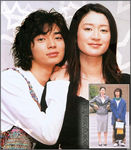 beginning of the story,
she desperately observes her ex-boyfriend, an inferior salary-man of the same
company, leaving her for an unexceptional girl. Sumire realizes that her
model-like tall-size, her beauty, her smart and strong personality and her
position in the company do not help her to succeed in life. On the opposite,
her amazing qualities and her strength frighten all the men around her.
Disgusted by this paradox, she remembers the only male creature who ever
accepted to stay in her shadow: her former dog, Momo. Then she meets he way of
a lost and no-resources dancer who accepts to be nothing more than her “pet”.
beginning of the story,
she desperately observes her ex-boyfriend, an inferior salary-man of the same
company, leaving her for an unexceptional girl. Sumire realizes that her
model-like tall-size, her beauty, her smart and strong personality and her
position in the company do not help her to succeed in life. On the opposite,
her amazing qualities and her strength frighten all the men around her.
Disgusted by this paradox, she remembers the only male creature who ever
accepted to stay in her shadow: her former dog, Momo. Then she meets he way of
a lost and no-resources dancer who accepts to be nothing more than her “pet”.
In front of these super-women, the non-hero
of Densha otoko embodies the confusion
of the Japanese men. This poor, pitiful  and ridiculous otaku’s life suddenly changes when he meets, in the train, a
beautiful young woman. By chance, he saves her from troubles and enters her
life in an unexpected way. Their inequality is so obvious that the man
experiences the worst difficulty to conquer a certain dignity. At the end, it
seems that the conception of “man-being” is totally dependant of the one of
“woman-being” the Japanese women decided to take in charge by their own.
and ridiculous otaku’s life suddenly changes when he meets, in the train, a
beautiful young woman. By chance, he saves her from troubles and enters her
life in an unexpected way. Their inequality is so obvious that the man
experiences the worst difficulty to conquer a certain dignity. At the end, it
seems that the conception of “man-being” is totally dependant of the one of
“woman-being” the Japanese women decided to take in charge by their own.
But the four girls of Tokyo Friends remind us that it is not
so easy to follow the “new Japanese way” for women. What happens to the girls
when they can not or do not want to adopt the male-like way of life? How are
they supposed to manage with their living without competing with men? Is there
a typical “female way of life” out of the housewife destiny?
to the girls
when they can not or do not want to adopt the male-like way of life? How are
they supposed to manage with their living without competing with men? Is there
a typical “female way of life” out of the housewife destiny?
The portraits of
these four art-oriented profiles (one sings, one studies art, one wants to
become a theatre actress…) provides some keys to understand the challenge of
the current Japanese women: establishing a new model for female emancipation.
CONCLUSION
From
the point of view of a Westerner, the Japanese drama are an amazing window
opened on the Japanese society self-thinking. Avoiding direct judgment, they
show us the complexity of individual and collective jibun-sagashi. Far from presenting standards, they challenge the
concept of human “categories” and the limit of stereotyped situations. In
addition, as manga, they are at the same time the product of a popular industry
and the reflection of a strong cultural identity. Through their scenario and
their protagonists, they offer interpretation tools to understand at least a
part of the issues which characterize the contemporary Japanese society.
Thank you for your attention
For any further details, feel free
to contact the author:
noemiefachan@gmail.com
List of
quoted Drama
Anego
11 episodes, 2005
Brother
Beat
11 episodes,13th October 2005 – 22th December 2005
Every Thursday, 9pm on TBS
Theme song: Broken Heart by Def Tech
Densha
Otoko
12 episodes, 7th July – 22th September 2005
Every Thursday, 10pm on Fuji TV
DragonZakura
11 episodes, 7th August 2005 - 16 September 2005 onTBS
Gokusen
1 et 2
April – July 2002 (season1) ; January - Mars 2005
(season 2)
Every Saturday, 9pm on NTV
Opening theme: Feel your breeze by V6
Hana
Yori Dango
9 episodes, 21st October – 16th December 2005
Every Wednesday, 10pm on TBS
Second season in 2007.
Ikebukuro
West Gate Park
11 episodes, 14th April – 23th June 2003 on TBS
Opening theme: Boukyaku no Sora (SADS)
Kimi wa
petto
2003
Kurosagi
11 episodes, 14th April – 23th June 2006 on TBS
Opening Theme: Daite Senorita by Yamashita Tomohisa
Nobuta
wo produce
10 episodes, 15th October – 17th December 2005
Every Saturday, 9pm on NTV
Theme song: Seishun Amigo by Kamenashi K. and
Yamashita T.
Sapuri (Suppli)
11 episodes from 10th July 2006
Every Monday 9pm on Fuji TV
Opening theme: Smile by KAT-TUN / Ending theme: Real
voice by Ayaka
Tokyo
friends
5 episodes from 3rd June 2005 on Fuji TV
Theme song: Friends by Otsuka Ai, To Me by Boo Bee
Benz
To learn more about J-drama:
A
complete listing of the production details and short summaries of j-drama since
1963.
Japanese TV drama that go
beyond Japan
(Pr.
Koichi Iwabuchi)
http://www.jamco.or.jp/2004_symposium/en/iwabuchi/index.html
DramaWiki
http://wiki.d-addicts.com/Main_Page
Grottamare-Tokyo
From an island to an island - 列島から列島まで
Welcome at the little British La Roux's concert at Dankayama, Tokyo !
She made us dance, she made us sing, she was great. Here are the official pictures and one of her video.
ラルという歌手のコンサートに行きました。よく踊って、よく歌って、本当に面白かったです。写真とヴィデオを見てください。


/https%3A%2F%2Fstorage.canalblog.com%2F35%2F77%2F571165%2F111404215_o.jpg)
/https%3A%2F%2Fstorage.canalblog.com%2F86%2F39%2F571165%2F111404156_o.jpg)
/https%3A%2F%2Fstorage.canalblog.com%2F22%2F21%2F571165%2F108003869_o.jpg)
/https%3A%2F%2Fstorage.canalblog.com%2F34%2F83%2F571165%2F108003851_o.jpg)
/https%3A%2F%2Fstorage.canalblog.com%2F13%2F55%2F571165%2F108003836_o.jpg)








